Great Synagogue of Vilna
| Great Synagogue of Vilnius | |
|---|---|
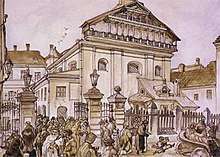 Watercolor by Juozas Kamarauskas (1899) | |
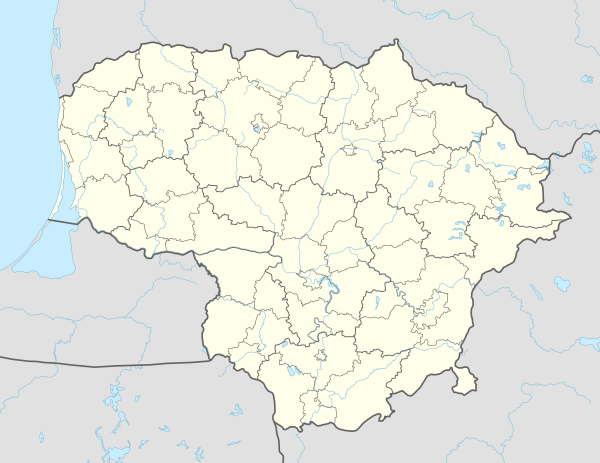 Shown within Lithuania | |
| Basic information | |
| Location | Vilnius' Old Town, Lithuania |
| Geographic coordinates | 54°40′48″N 25°17′05″E / 54.68000°N 25.28472°ECoordinates: 54°40′48″N 25°17′05″E / 54.68000°N 25.28472°E |
| Affiliation | Orthodox Judaism |
| Rite | Ashkenaz |
| Status | Destroyed |
| Architectural description | |
| Architectural style | Renaissance-Baroque |
| Completed | 1572. Rebuilt 1633. |
| Demolished | 1955–1957 |
| Capacity | 5,000 |
The Great Synagogue of Vilna, which once stood at the end of Jewish Street (I-2), Vilnius, Lithuania, was built between 1630 and 1633 after permission was granted to construct a synagogue from stone. Standing on the spot of an existing synagogue built in 1572, the site had first been used to house a Jewish house of prayer in 1440. Damaged in World War II, it was demolished in 1955–1957 and replaced by a kindergarten and a primary school.
Structure
The synagogue had a number of entrances. One, at street level, consisted of a pair of iron gates that had been donated by a tailors' society in 1640. The other entrance on the western side, added in 1800, was a bit more imposing: it had an elevated two-tiered wooden gable with a portal and wrought iron posts. There was a heavy iron door with an original Hebrew inscription indicating it was a gift of a "society of Psalm reciters" in 1642. At the time of its building, ecclesiastical regulations all through Europe specified that a synagogue could not be built higher than a church. To obey the law, and yet create the necessary interior height, it was customary to dig a foundation deep enough for the synagogue's floor level to be well below that of the street. Outside, the synagogue looked to be about three stories tall, but inside it reached to over five stories. Another entrance with a vestibule and the "pillory" was located on the northern side of the building.
The interior of the synagogue was redesigned in the mid-18th century by Vilnian German Johann Christoph Glaubitz in the Italian Renaissance style. Four massive, equidistant columns supported the vast stone-floored pile, and within them was the three-tiered ornate, rococo bimah, with a cupola, supported by eight small columns. It was built in the second half of the 18th century by Rabbi Judah ben Eliezer (commonly known as the YeSoD– an acronym of the three words Yehudah Sofer ve-Dayyan), a scribe and judge.
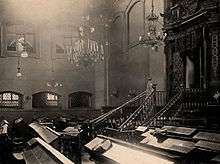
The two-tiered Holy Ark on the eastern wall was carved with gilded woodcarvings, representing plants, animals and Jewish symbols, with a double-headed eagle on top. It was approached by a twofold flight of steps, with iron balustrades, ascending from the right and the left. Hanging from the walls and ceilings there were numerous bronze and silver chandeliers. The synagogue contained a valuable collection of ritual objects. The building was repaired in the 19th century.
Formerly there was a seven-branched brass candelabrum in front of the Ark, but on the eve of the German invasion of the city during World War I, it was sent off to Moscow. There also once was a "Chair of Elijah" in the northwest corner on which the rite of brit milah was performed.
On both sides of the Holy Ark there were two-story structures, serving as the women's sections, connected to the prayer hall by little windows. Another gallery for women was situated along the north side, also consisting of two floors built by Noah Feibusch Bloch, a community elder who advanced the money and when the community was unable to return the 14,000 gulden due, he made a present of the structure.
The main prayer hall was square and could hold 300 people. The synagogue was also intended to serve as a stronghold within which the Jews could take refuge in times of danger. On the High Holy Days before World War II the synagogue held 5,000 worshipers.
In 1846, when Sir Moses Montefiore visited the synagogue, the treasurers distributed entrance tickets to the masses of people.
Destruction
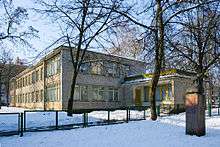
The synagogue was looted, burned and partly destroyed by the Nazis during World War II. The ruined synagogue and the whole "schulhof" complex that had grown around it were demolished by the Soviet authorities from 1955 to 1957 and were intentionally replaced by a basketball court and a kindergarten to effectively prevent any future initiatives to rebuild a cultural monument. The kindergarten was later replaced by a primary school.
Three original pieces from the Great Synagogue of Vilna survived the destruction quite miraculously and are now on display at the Vilna Gaon Jewish Museum: a door of the Holy Ark, a reader’s desk, and a bas-relief with the Ten Commandments.
Plans of restoration
In 2011, Lithuanian Prime Minister Andrius Kubilius and Vilnius Mayor Artūras Zuokas announced plans to restore the synagogue, after successful archaeological exploration of synagogue ruins in the same year.[1] In 2014, Israeli president Shimon Peres, who was introduced to the project during his official visit in Lithuania in 2013, was invited to join the board, together with Lithuania's former President Valdas Adamkus, Lithuanian PM Algirdas Butkevičius and the prominent architect Daniel Liebeskind for the restoration project.[2] The project's Israeli architect, Tsila Zak, elaborated her original plans that had been already adopted by the municipal authorities of Vilnius in 1993, following an international competition in 1989-1990 in which she participated together with the Swedish sculpture Willy Gordon.
The original walls of the Great Synagogue were pinpointed by a team of archaeologists from the Israel Antiquities Authority, the Hebrew University of Jerusalem, and three American universities[3] using ground-penetrating radar in June 2015 beneath the grounds of modern school building.[4] Excavations began in 2016, when a group led by Dr. Harry Gol of the American University of Wisconsin–Eau Claire excavated what is thought to be a portion of the synagogue's mikveh.[5][6] In July 2018, the archaeologists announced the discovery of the Baroque bimah. Vilnius Mayor Remigijus Šimašius said that the plans were to demolish the Soviet-built premises, since the primary school had moved out in 2017, and replace it with a meaningful memorial and exposition of the ruins, but not a complete reconstruction of the synagogue, to be completed by 2023.[7]
Gallery
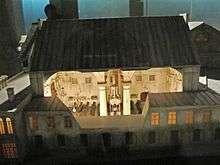 Model of the Great Synagogue of Vilna at the Diaspora Museum, Tel Aviv
Model of the Great Synagogue of Vilna at the Diaspora Museum, Tel Aviv Postcard c.1920
Postcard c.1920 Western flank
Western flank- Eastern flank
- Gate to the courtyard
See also
References
| Wikimedia Commons has media related to Great Synagogue in Vilnius. |
- ↑ Vilniaus Didžiosioji sinagoga bus atstatyta?
- ↑ Peres invited to advise on restoration of Vilnius synagogue
- ↑ Rogers, James (2015-08-07). "Radar technology helps rediscover the Great Synagogue of Vilnius, 70 years after its destruction". Fox News. Retrieved 2018-04-16.
- ↑ Geggel, Laura (August 3, 2015). "Remains of Synagogue Destroyed by Nazis Found With Radar". NBC News. Retrieved August 4, 2015.
- ↑ Grogan-Ripp, Lucy (17 Nov 2017). "Blugolds find closure for Holocaust victims". UWEC News. University of Wisconsin–Eau Claire. Retrieved 16 April 2018.
- ↑ NOVA. "Holocaust Escape Tunnel" (Video). Public Broadcasting Service. WGBH. Retrieved 16 April 2018.
- ↑ Levickytė, Paulina (26 July 2018). "Šimašius: apie Didžiosios sinagogos atstatymą kalbos nėra" (in Lithuanian). ELTA via delfi.lt. Retrieved 26 July 2018.
External links
- The Great City Synagogue of Vilna - The Museum of the Jewish People at Beit Hatfutsot
- Stanley Mann: The City That Could Not Be Vanquished
- The Great Synagogue in the Bezalel Narkiss Index of Jewish Art